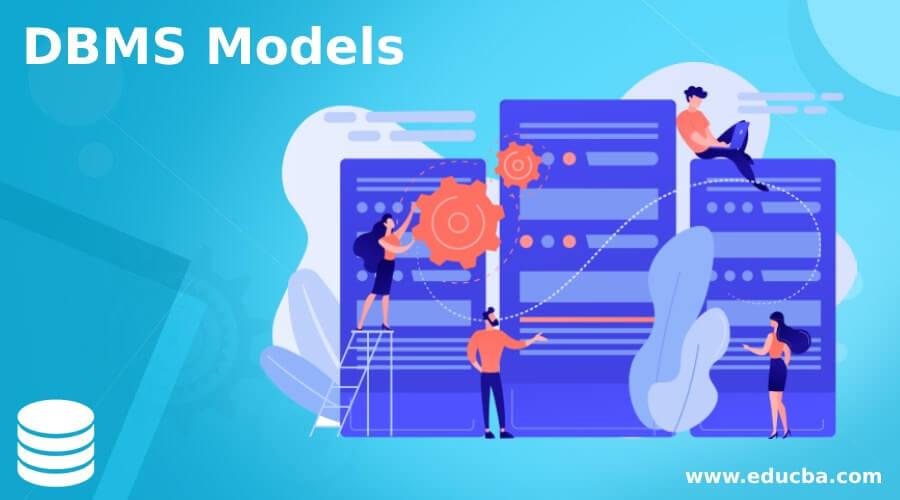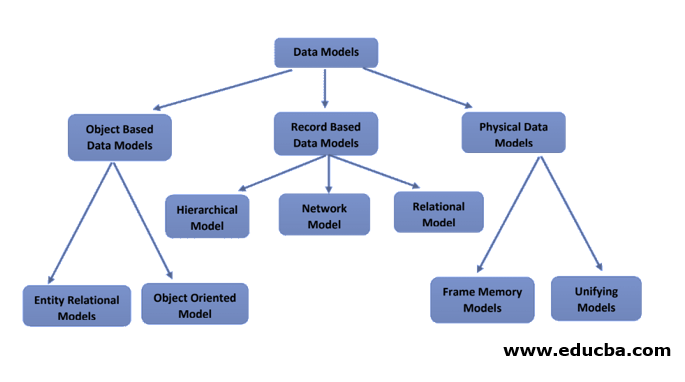Updated March 8, 2023

Introduction to DBMS Models
The following article provides an outline for DBMS Models. DBMS Model is defined as the logical plan and arrangement of a database which describes how the data info will be stored, retrieved and modified in a database management system. This DBMS Model illustrates the coherent structure of a database server that consists of the relationships and limitations which helps to regulate how data information can be preserved and fetched later. Database models can be independently designed on the basis of guidelines and ideas of whichever larger data model the creators approve.
Each of these data models mostly can be signified by a supplementary database illustration. There are different kinds of DBMS Models which matches to different phases of the database design procedure. In this case, the high-level conceptual DBMS models could be the superlative to map out the DBMS relationships between records in ways in which the public observe that info. On the other hand, the record-based DBMS logical models will more diligently echo the ways that the records are stored on the DBMS server.
Different DBMS Models
There prevail several sorts of DBMS models, but the most communal ones consist of the following mentioned below:
- Relational Model
- Network Model
- Hierarchical Model
- Object-Oriented Database Model
- Object Relational Model (It syndicates the two which create up its name)
- Entity-Relationship Model
- Record Based DBMS Model
- Document Database Model
1. Relational Model
This relational model is the most popular type of DBMS model that categories data into database tables named relations, each of which includes table rows and columns. Here, every column holds an attribute of the entity in question like pin code, cot, dob, etc. when the attributes are together in a relationship, then it is called a domain. Also, a distinct attribute or group of attributes is selected as a primary key that can refer to other tables when it is known to be a foreign key. The table row known as tuple comprises info about a distinct object of the entity in question, like as a specific employee.
This model generates one to one, many to many and one to many relationships. The tables can be normalized within the database by following certain rules where every piece of data is broken into small or, say, nuclear pieces, which are beneficial. This type of relational databases is normally written in SQL (Structured Query Language) commands. This relational model was announced in the year 1970 by E.F. Codd.
2. Network Model
This model figures on the hierarchical model by permitting the relationship of many to many between the associated records, indicating various parent records. On the basis of the mathematical set theory, with the help of sets of associated records, the model is created. Every set includes one owner or, say, parent record and child records or one or more members.
Here, the record may be a child in numerous sets or a member who permits this type of model to assign difficult relationships. In the 70s, this type of relationship was most prevalent after it was officially stated by the CODASYL (Conference on Data Systems Languages).
3. Hierarchical Model
In the Hierarchical model, data records are arranged into a tree-like organization, where every record includes only a root or a parent. The sibling records are arranged in specific in a distinct order which is then implemented as the physical order for storing the database. For explaining several real-world relationships, this type of model is useful.
In the ’60s and ’70s, this model was normally implemented by IBM’s Information Management Systems. However, due to few functioning disorganizations, they are infrequently seen currently.
4. Object-Oriented Database Model
This model denotes a database as a collection of reusable software elements or objects along with the related methods and features. It includes a multimedia database type comprising media elements and a hypertext database that lets any object associate to any other object.
This model is best known as the post-relational database model because it integrates tables. Also, it is known as a Hybrid database.
5. Object Relational Model
In this type of model, the hybrid model gets together with the effortlessness of the relational model with few of the enhanced functionality of the object-oriented model. It permits creators to integrate objects into acquainted table structure.
6. Entity-Relationship Model
This model aids to capture the relationships between real-world objects such as the network model, but even then, it is not openly tied to the physical structure of the database. Hence, it is typically applied for creating a database abstractly. An entity that comprises a real-world property known as an attribute is stated as a set of domain values.
7. Record Based DBMS Model
This model is responsible for regulating the overall design of the database, including several sorts of record types. Every record types contain a fixed length and also fields.
8. Document Database Model
It is a kind of non-relational database which is created to store as well as query data such as JSON documents. A communal form of ER diagram can be defined as a star schema, where an essential element table associates to several dimensional tables.
DBMS model diagram as follows:
Aside, these DBMS model, some other variety of database models are still being implemented today, listed as follows:
- Inverted File Model
- Flat Model
- Multidimensional Model
- Semistructured Model
- Context Model
- Associative Model
Even a few other uncommon types of DBMS models consists:
- Named Graph
- XML Database
- Semantic Model
- Triplestore
Conclusion
The DBMS Models accounts to show the forms of relationships between the database tables consisting of one-to-one, many-to-many and one-to-many relationships. This helps for the normalization of the database, which makes DBMS adjustable, flexible and accessible. We should be confirmed about the greatest factor that whether the database system that is being used either supports any specific model or not. Choosing a DBMS model needs a matter of supporting the user’s primacies for the database with the powers of a specific model, whether these primacies comprise speed, price saving, usability or somewhat else.
Recommended Articles
This is a guide to DBMS Models. Here we discuss the introduction and the different DBMS models for a better understanding. You may also have a look at the following articles to learn more –

